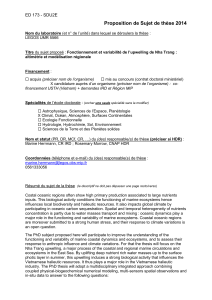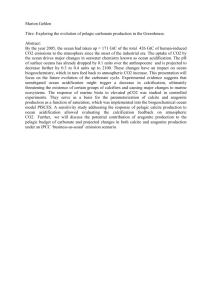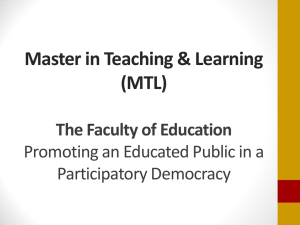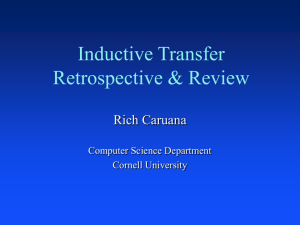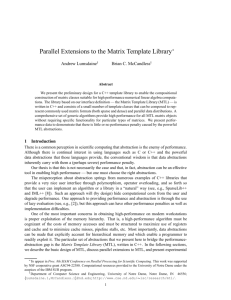Sujet de thèse 2009-2012
advertisement
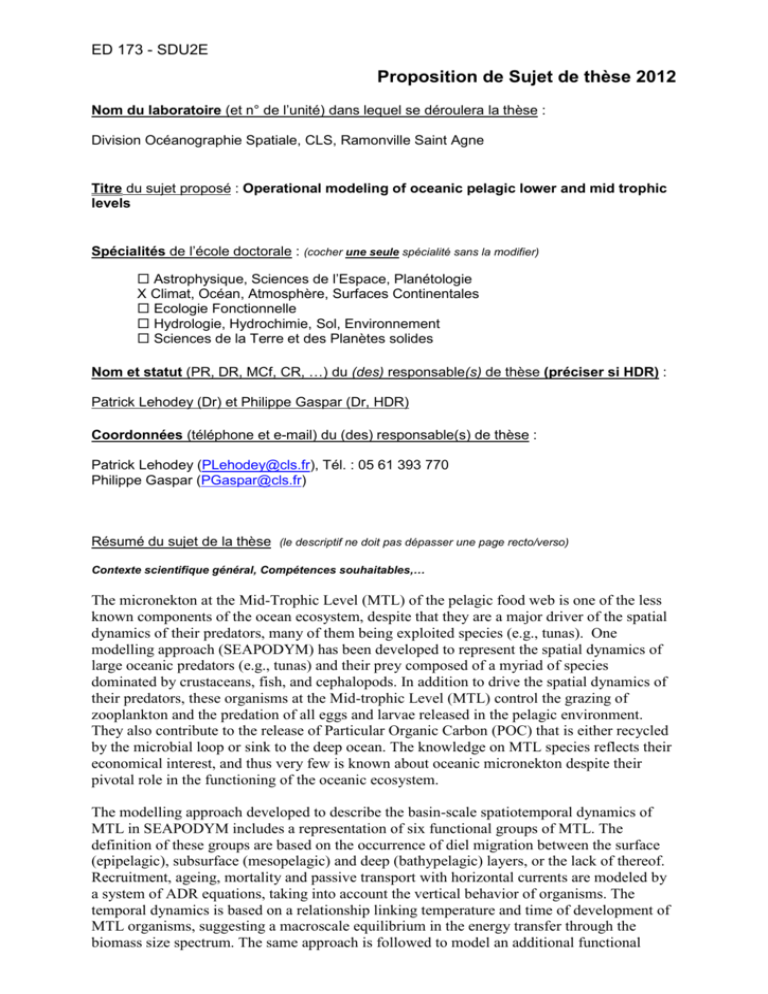
ED 173 - SDU2E Proposition de Sujet de thèse 2012 Nom du laboratoire (et n° de l’unité) dans lequel se déroulera la thèse : Division Océanographie Spatiale, CLS, Ramonville Saint Agne Titre du sujet proposé : Operational modeling of oceanic pelagic lower and mid trophic levels Spécialités de l’école doctorale : (cocher une seule spécialité sans la modifier) Astrophysique, Sciences de l’Espace, Planétologie X Climat, Océan, Atmosphère, Surfaces Continentales Ecologie Fonctionnelle Hydrologie, Hydrochimie, Sol, Environnement Sciences de la Terre et des Planètes solides Nom et statut (PR, DR, MCf, CR, …) du (des) responsable(s) de thèse (préciser si HDR) : Patrick Lehodey (Dr) et Philippe Gaspar (Dr, HDR) Coordonnées (téléphone et e-mail) du (des) responsable(s) de thèse : Patrick Lehodey (PLehodey@cls.fr), Tél. : 05 61 393 770 Philippe Gaspar (PGaspar@cls.fr) Résumé du sujet de la thèse (le descriptif ne doit pas dépasser une page recto/verso) Contexte scientifique général, Compétences souhaitables,… The micronekton at the Mid-Trophic Level (MTL) of the pelagic food web is one of the less known components of the ocean ecosystem, despite that they are a major driver of the spatial dynamics of their predators, many of them being exploited species (e.g., tunas). One modelling approach (SEAPODYM) has been developed to represent the spatial dynamics of large oceanic predators (e.g., tunas) and their prey composed of a myriad of species dominated by crustaceans, fish, and cephalopods. In addition to drive the spatial dynamics of their predators, these organisms at the Mid-trophic Level (MTL) control the grazing of zooplankton and the predation of all eggs and larvae released in the pelagic environment. They also contribute to the release of Particular Organic Carbon (POC) that is either recycled by the microbial loop or sink to the deep ocean. The knowledge on MTL species reflects their economical interest, and thus very few is known about oceanic micronekton despite their pivotal role in the functioning of the oceanic ecosystem. The modelling approach developed to describe the basin-scale spatiotemporal dynamics of MTL in SEAPODYM includes a representation of six functional groups of MTL. The definition of these groups are based on the occurrence of diel migration between the surface (epipelagic), subsurface (mesopelagic) and deep (bathypelagic) layers, or the lack of thereof. Recruitment, ageing, mortality and passive transport with horizontal currents are modeled by a system of ADR equations, taking into account the vertical behavior of organisms. The temporal dynamics is based on a relationship linking temperature and time of development of MTL organisms, suggesting a macroscale equilibrium in the energy transfer through the biomass size spectrum. The same approach is followed to model an additional functional ED 173 - SDU2E group for mesozooplankton and further developments could consider also including a representation of organisms strictly associated to the surface (neuston, including many jelly fish species) or the bottom (benthos) of the ocean. This representation requires a limited number of parameters and allowed preliminary development of a parameter optimization approach through data assimilation techniques based on acoustic data. The parameterization of the total energy transfer requires absolute biomass estimates obtained using calibrated biomass estimates combining acoustic and micronekton net sampling used to convert backscatter values in micronekton biomass, after careful discrimination between various recorded patches of records. The matrix of energy transfer coefficients for each functional group can be estimated simply using relative day and night values of acoustic backscatter integrated in each of the three vertical layers of the model. Such acoustic data are collected in various parts of the World Ocean and collaborations developed with several national and international laboratories will be useful to process a database for assimilation allowing both parameter optimization and validation of the model. Therefore, in this PhD study, we propose new developments and analyses to produce consolidated and validated global simulations of the zooplankton and micronekton functional groups, relying on rigorous mathematical techniques to develop an innovative approach for assimilating acoustic data in an ocean ecosystem model. The final objective is to propose new operational products based on multi-satellite data and modeling, that will open the way to many new applications, including the operational management of marine resources and the monitoring of protected species. References: Lehodey P., Murtugudde R., Senina I. (2010). Bridging the gap from ocean models to population dynamics of large marine predators: a model of mid-trophic functional groups. Progress in Oceanography, 84: 69–84 Handegard, N.O., Demer, D., Kloser, R.J., Lehodey, P., Maury, O., Simard, Y. (2010). "Toward a Global Ocean Ecosystem Mid-trophic Automatic Acoustic Sampler (MAAS)" in Proceedings of OceanObs’09: Sustained Ocean Observations and Information for Society (Vol. 2), Venice, Italy, 21-25 September 2009, Hall, J., Harrison D.E. & Stammer, D., Eds., ESA Publication WPP-306. Lehodey, P., Senina, I., Calmettes, B., Royer, F., Gaspar, P., Abécassis, M., Polovina, J., Parker, D., Domokos, R., Hernandez, O., Dessert, M., Kloser, R., Young, J., Lutcavage, M., Handegard, N.O., Hampton, J. (2010). Towards Operational Management of Pelagic Ecosystems. ICES CM Documents 2010, 20-24 Sep., Nantes, France. 13 pp. ISBN 978-87-7482-085-7. This thesis will be performed in an international collaboration framework including Rudy Kloser (CSIRO, Australia); Reka Domokos (NMFS, USA) and C. Guinet (CNRS, France). It will contribute to several major projects : FP7 EURO-BASIN, ANR Mycto3DMap and GMMC Mercator Vert. The candidate shall have a significant background in physical oceanography, marine biology numerical modeling and scientific programming (preferably in C/C++).




